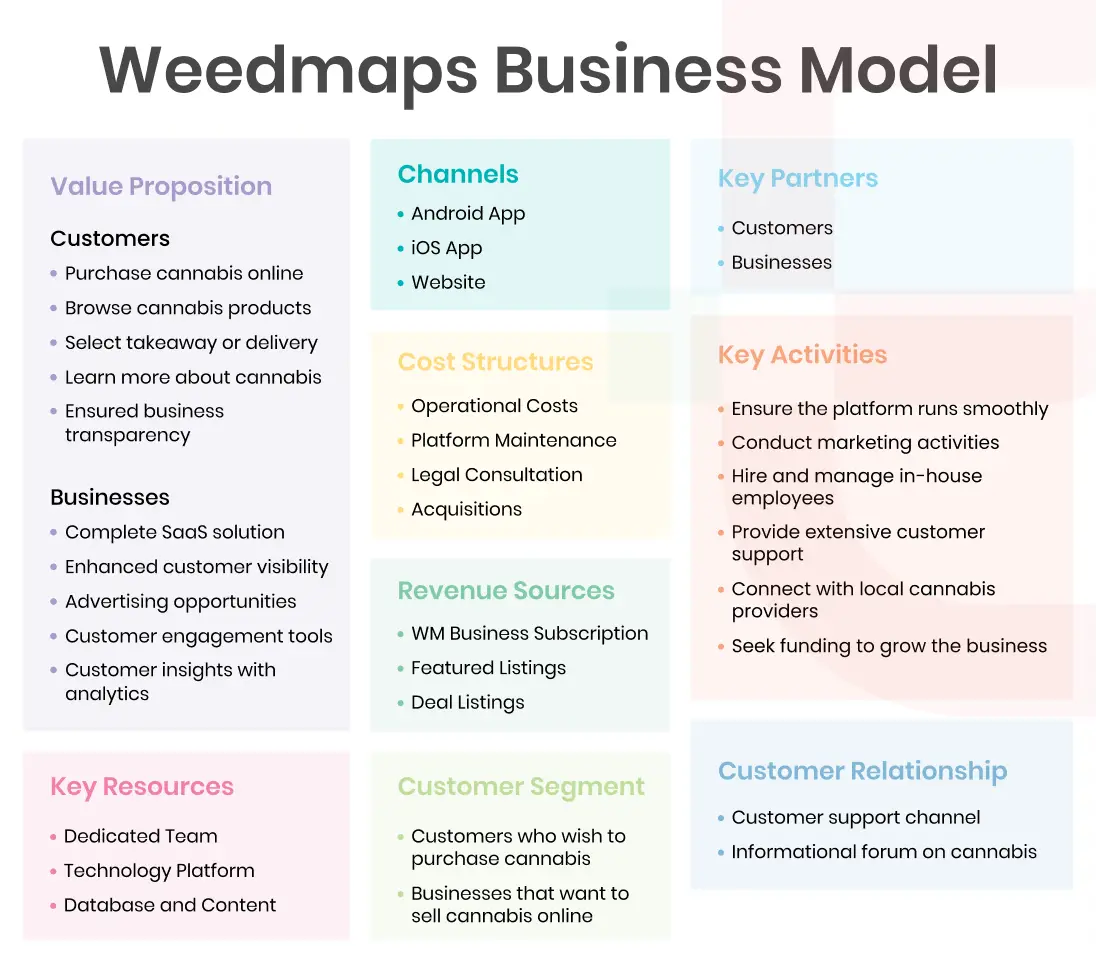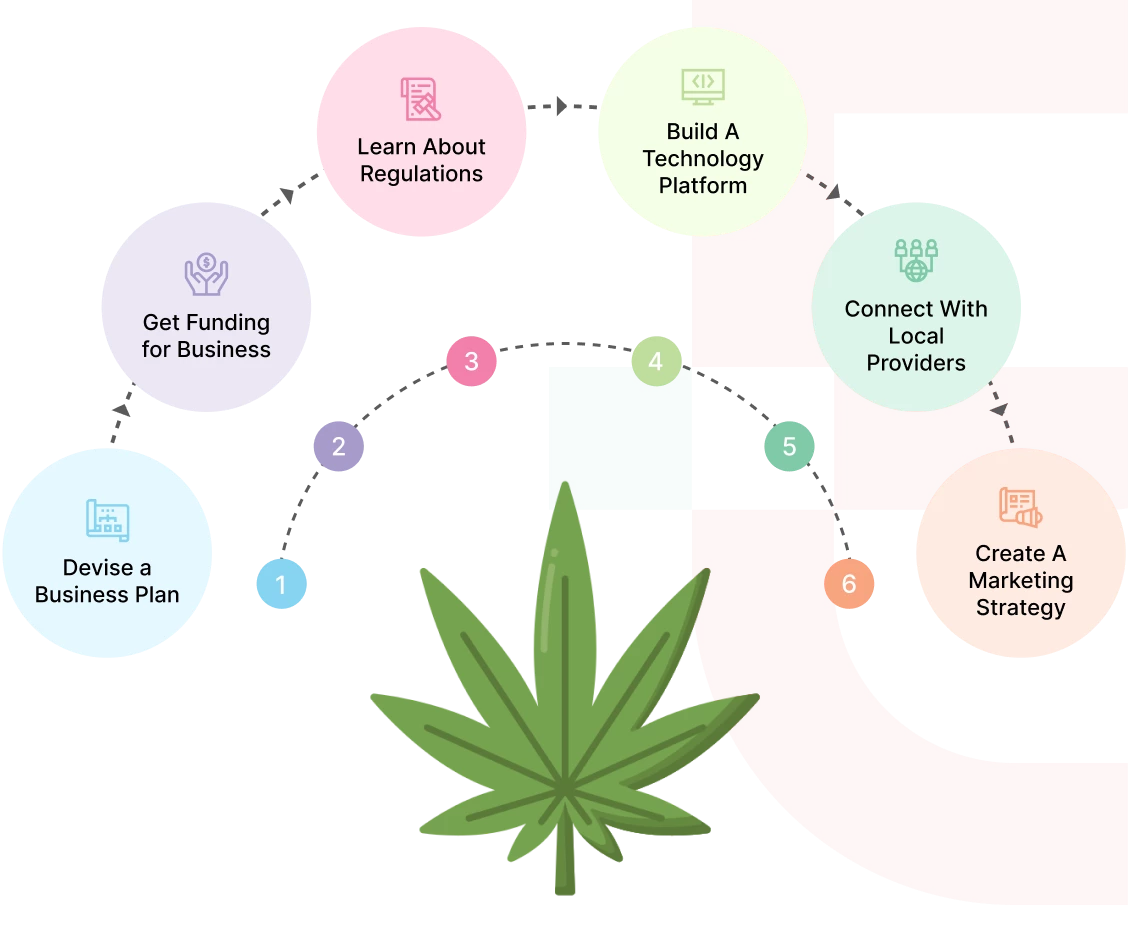
Weedmaps has emerged as one of the leading platforms for customers to find cannabis providers and explore purchasing options for medicinal and recreational use. The Weedmaps business model allows the company to work as a bridge between customers and cannabis sellers, acting as a mediator platform for cannabis trades.
The cannabis market has seen a massive boost in recent years, as many studies have revealed its consumption benefits. This encouraged governments to give cannabis-related businesses a green signal. The legalization has had a positive impact on the market, with cannabis-related businesses predicted to reach US$83.56bn by 2030.
Interested in building a business around cannabis and want to learn more about Weedmaps? Here, you will explore its complete business model, including workflow and revenue sources. But before we delve into that, let’s explore Weedmaps’ founding journey.
Weedmaps Success Story: How Did It Start?
Weedmaps is a brainchild of Justin Hartfield and Keith Hoerling. Two friends teamed up and founded the platform in 2008. At that time, cannabis wasn’t sold freely as a recreational drug, and anyone trying to do so would have to face legal consequences.
However, the government is okay with publishing information online. Therefore, Weedmaps started as an informational platform where medicinal cannabis patients can connect with other patients and share their feedback on local dispensaries.
The platform received a massive response and became instantly popular among consumers.
In 2010, just two years after its establishment, Weedmaps was bought by General Cannabis Incorporated. However, Hartfield stayed in, serving as Chief Web Officer for the platform.
Next year, in 2011, Weedmaps collaborated with the National Organization for the Reform of Marijuana Laws (NORML), which helped the company revamp its site and work towards legalizing marijuana.
In November 2011, Weedmaps acquired Marijuana.com, including the domain name and website, for US$4.20 million.This acquisition helped Weedmaps position itself as the go-to source for all things related to cannabis.
In February 2013, General Cannabis, Inc. sold all its cannabis-related businesses, including Weedmaps, back to the platform’s original founders. Justin Hartfield and Keith Hoerling once again became Weedmaps’ owners. The company, since then, has stood out as the most sought-after place for ordering cannabis.
The company went public in 2021, showcasing its growth as a thriving cannabis ordering platform. According to MarketWatch, in 2024, the owner proposed taking the company private. At the time this article is being written, the proposal is under review, and the company has not been delisted yet.
As countries improve their legislation regarding cannabis consumption, the market is increasingly expanding its volume. Weedmaps is one of the forerunners and enjoys the first-mover advantage.
Despite having numerous competitors, the Weedmaps business model has enabled the company to remain strong in the industry, maintaining its position at the top. Let’s discuss its business model and try to understand what makes it so robust.
Breaking Down the Weedmaps Business Model to Understand Its Different Aspects
The Weedmaps business model enables the company to operate as both a B2C e-commerce platform and a SaaS business solution. So, the Weedmaps’ customer segment entails both cannabis retailers and consumers. The company, however, does not play an active role in any business operations. It just connects both of them through its platform.
Below, we have broken down the Weedmaps business model into segments that help clarify who the company’s clients are, what benefits they receive, and what key activities the company undertakes to maintain its business.
Key Partners
These are Weedmaps’ key partners that engaged with the platform:
- Customers: Users who browse local providers and their products, read reviews, and order cannabis for delivery or pick-up.
- Businesses: Cannabis providers who list and sell their products on the Weedmaps platform.
Value Proposition
Value Proposition for Customers
- Customers use the platform to purchase cannabis online and explore nearby dispensaries.
- With a wide product range, customers have a myriad of products to browse.
- Customers enjoy home delivery and takeaway options, depending on the providers.
- Customers increase their cannabis knowledge through the dedicated learning section.
- Customers go through a transparent purchasing experience with reliable providers.
Value Proposition for Businesses
- Dispensaries and delivery-only firms get a complete SaaS solution from Weedmaps.
- Cannabis providers enhance their customer visibility and grow their businesses on the platform.
- Cannabis sellers can advertise their business within the platform and generate leads.
- With features like WM CRM, businesses can enhance customer engagement and interaction.
- With analytical insights, businesses gain a deeper understanding of their customers’ preferences and behaviors.
Key Activities
- Continuously maintaining the platform to ensure it runs smoothly.
- Conducting marketing campaigns to attract new customers.
- Hiring and managing in-house employees to manage various business tasks.
- Providing extensive support to resolve customers’ queries and concerns.
- Connecting with local cannabis providers to expand the online repository.
- Continuously seek funding to expand the business into other cities and countries.
Bring Digital Transformation to Your Cannabis Delivery Business With Our Advanced Weedmaps Clone
Understanding How Weedmaps Makes Money
Weedmaps connects customers with cannabis providers. Unlike other aggregator businesses, the company doesn’t handle payments or delivery on its platform. Thus, it doesn’t earn from order commissions or delivery fees.
However, the company still profits from its diverse sources. Here, we will discuss Weedmaps’ multiple revenue streams and attempt to understand how Weedmaps makes money.
WM Business Subscriptions
The earnings on WM business subscriptions help the company make a significant profit. Weedmaps offers a software bundle that includes various business management and growth tools. This tool suite provides cannabis retailers with a platform to conduct their critical business operations seamlessly.
Featured Listings
The company’s featured listing program is another revenue source. Through this program, cannabis retailers can boost their product listings on the platform to increase visibility and drive more sales. The platform charges specific fees for this service, allowing it to generate another revenue source.
Deal Listings
Weedmaps also charges specific fees to promote its retailers’ discount programs. Retailers offering special deals and discounts on their products can highlight them in the Deal Listings. The highlighted discounts boost viability and encourage customers to purchase products, increasing the retailer’s sales.
Brief Guide On Starting A Cannabis Delivery Business
Starting a cannabis delivery platform is almost the same as starting any other online marketplace. However, since this sector is highly regulated, there are certain things to avoid.
Below, we shared our wisdom on how to start a cannabis delivery business. Refer to this step-by-step guide to build a robust cannabis ordering marketplace.
Step #1: Devise a Business Plan
The first step in building a cannabis delivery business is to devise a robust business plan that clearly defines your business goals. At this stage, you may also want to decide on your company’s structure, branding elements, working strategies, and all other necessary document work.
Step #2: Get Funding for Business
After creating a business plan comes acquiring funds. Pitch your business idea to investors and secure funding. Before you go to your potential investor, ensure your stats are ready.
How much funding do you need? How will you distribute them? What is your five-year plan? And how will you execute it?
Make sure you provide satisfactory answers to convince your investors.
Step #3: Learn About Regulations
The laws around cannabis delivery are complicated. If you’re starting this business, learning about the laws is crucial for you. Anything missed will not only result in lawsuits and hefty fines but will also damage your business reputation. If you are not sure about its laws and regulations, consult a legal professional before entering the market.
Step #4: Build A Technology Platform
Next, you will need to start building your online cannabis-selling platform. Find a reliable development team that will build a robust platform for you. Your development team directly affects the quality of your platform, so take your time and choose wisely. Build a platform with all the essential features and functionalities that make cannabis ordering seamless.
Step #5: Connect With Local Providers
Once your platform is ready, it’s time for the launch. Invite local cannabis retailers and ask them to list their products on it. You can earn on a commission-based model where you charge a small commission fee on each order, or try a subscription model where you take upfront subscription charges, just like Weedmaps does.
Step #6: Create A Marketing Strategy
Now, you have products to offer on your platform. Your job is to bring buyers to buy them. Create an effective marketing strategy and start promoting your platform. Devising a multi-channel strategy will help you increase brand visibility across all the platforms and bring leads to your cannabis ordering app.
Summing It Up
Despite stringent regulatory hurdles, the Weedmaps business model has enabled the company to offer a seamless ordering platform, making it one of the go-to sources for purchasing cannabis. If this article has inspired you to dive into the cannabis market and you’re now seeking a development firm to build your app, Elluminati is here for you.
We have an advanced Weedmaps clone that can simplify your business operations. Our professional developers can create a customized solution that represents your brand. Pitch your requirements to us, and we will provide a customized quote. Let’s partner up and build a successful cannabis delivery platform together.













